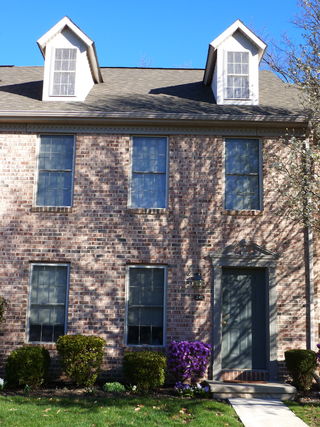Relationships
Learning to Love the Suburbs
I vowed I would never live in the suburbs. But here I am, and it’s not so bad.
Posted December 29, 2018

I grew up in a ranch house in a Pennsylvania suburb, and I promised myself I would never live in any place remotely similar as an adult.
To me, the suburbs were a blank, featureless plain—devoid of nearly everything necessary to make life interesting. Residents needed a car—and, until I was 16 and got my license—a driver (i.e., a parent) to get anywhere. Even walking was hard in my neighborhood. The streets didn’t have sidewalks; the builders seemed intent on isolating residents from each other as much as possible.
For many years, I kept my vow to give the suburbs a pass. I went to college in Washington, D.C., and graduate school in Buffalo and New York City. I lived in Washington again and then in Honolulu for 14 years before returning to Pennsylvania to help care for my ailing mother. In my decades of wandering, I managed to avoid the suburbs: My dwellings, all of them rentals, were well within the limits of whatever city I called home.
When I moved back to Pennsylvania in 2003, I found a cozy one-bedroom in a stylish apartment building in a small city just five miles from my childhood home. I lived there for 13 years, and I took maximum advantage of my city-dweller status.
I walked to work, to dinners at city restaurants, and to concerts at nearby performance spaces. I saw big names such as Boz Scaggs and Lyle Lovett, as well as countless local symphony performances—in venues a short walk from my apartment.
I was able to indulge my passion for jazz by strolling five blocks to a downtown hotel with an elegant bar in the lobby, which for years was home to a genial jazz pianist and his guest musicians. At an excellent local theater, I saw performances of several contemporary plays, including August Wilson’s mesmerizing “Century Cycle.” For exercise I jogged regularly on a lyrically beautiful walking path beside the broad river that bordered my city.
The Amtrak station—with service to Philadelphia and New York—was across the street; I could race out of my apartment, suitcase in hand, and be on my train in less than 15 minutes. I was even able to follow the popular dictum to “shop locally”—in a small gift shop a block from my apartment building and in a women’s clothing store just two blocks away.
I had to drive four miles to the grocery store, but my city locale had so much to offer that driving for groceries seemed a small sacrifice. I wasn’t in New York again, where I had lived happily for three years in my twenties. But in many ways I behaved as if I were living in New York.
Still, there were problems with my urban paradise—problems that became harder to ignore the longer I lived there. The gift shop and the women’s clothing store both closed; the hotel changed hands, and the new owners weren’t interested in having jazz in their lobby bar. The city started a major construction project on the street in front of my apartment—deafening work that took place from 10 p.m. to 6 a.m., when traffic was light and I should have been sleeping. My rent kept rising every year, but my apartment stayed the same size. Much as I hated to admit it, it was time to go.
After decades of renting, I took a deep breath and decided to buy. City row houses were popular with urban aficionados like myself, but they held no appeal for me. Most had been built in the early 1900s; they were quaint but seemed like money pits, and almost none of them had parking.
Instead, I was drawn to a townhouse complex seven miles north of the city. The two-story row houses there were moderately priced, with charming brick fronts, full basements, two assigned parking spaces and a rear deck. They were located in a leafy neighborhood at the base of a mountain, with wide streets and (hooray!) welcoming sidewalks. Two months after I first contemplated not renewing my apartment lease, I had bought a townhouse and was moving—to the suburbs.
I’ve been a suburbanite for two years now, and I am slightly abashed to confess that, for the most part, I like where I live. Perhaps most important, this is not the lily-white suburb of my childhood. My neighbors are an admirably diverse group in many ways—including ethnically, professionally and with respect to their stage of life. Many couples are interracial; no one bats an eye. And there is a real, if understated, spirit of community: My neighbors and I invariably say hello to each other or stop to talk when we meet at the mailboxes or are out for a walk.
The grocery store and two drug stores are just a mile away, as is a cluster of local eateries. These include an Asian place serving Chinese, Japanese and Thai food; an Italian spot; and a restaurant whose menu includes standard American diner fare plus baba ganoush, a falafel platter and hummus. It’s not New York, but neither is it the bland, faceless suburb of my childhood.
I have had to renege on a number of my childhood vows: To live in Paris. To write a novel. To never move back to Pennsylvania. I can’t easily explain what happened to the Paris plan or the novel, but I moved back to Pennsylvania to help care for my mother in her last years, and I have never regretted that decision. I like to think the childhood Susan would approve, if she had all the facts before her. And now the move to the suburbs. What can I tell my childhood self? Maybe this: It’s not forever, but it makes sense for now. And some suburbs, dear girl, are different from the one you grew up in. They have changed, for the better—and so have I.
Copyright © 2018 by Susan Hooper




